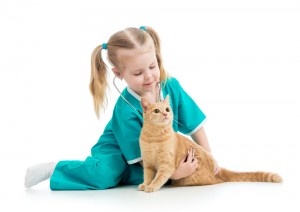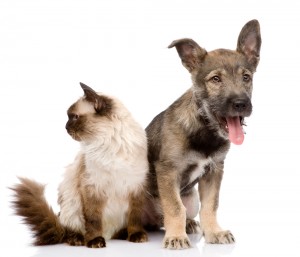Fleas And Your Pet
UNDERSTANDING THE FLEA
For millions of pets and people, the tiny flea is a remorseless enemy. The flea is a small, brown, wingless insect that uses specialized mouthparts to pierce the skin and siphon blood.
When a flea bites your pet, it injects a small amount of saliva into the skin to prevent blood coagulation. Some animals may have fleas without showing discomfort, but an unfortunate number of pets become sensitized to this saliva. In highly allergic animals, the bite of a single flea can cause severe itching and scratching. Fleas cause the most common skin disease of pets – flea allergy dermatitis.
If your pet develops hypersensitivity to flea saliva, many changes may result.
- A small hive may develop at the site of the fleabite, which either heals or develops into a tiny red bump that eventually crusts.
- The pet may scratch and chew at himself until the area is hairless, raw and weeping serum (“hot spots”). This can cause hair loss, redness, scaling, bacterial infection and increased pigmentation of the skin.
Remember that the flea spends the majority of its life in the environment, not on your pet, so it may be difficult to find. In fact, your pet may continue to scratch without you ever seeing a flea on him. Check your pet carefully for fleas or for signs of flea excrement (also called flea dirt), which looks like coarsely ground pepper. When moistened, flea dirt turns a reddish brown because it contains blood. If one pet in the household has fleas, assume that all pets in the household have fleas. A single flea found on your pet means that there are probably hundreds of fleas, larva, pupa and eggs in your house.
If you see tapeworm segments in your pet’s stool, he may have had fleas at one time or may still have them. The flea can act as an intermediate host of the tapeworm, Dipylidium caninum. Through grooming or biting, the animal ingests an adult flea containing tapeworm eggs. Once released the tapeworm grows to maturity in the small intestine. The cycle can take less than a month, so a key to tapeworm prevention is flea control. Anemia also may be a complication of flea infestation especially in young kittens and puppies.
THE LIFE CYCLE OF THE FLEA
The flea’s life cycle has four stages: egg, larva, pupa and adult.
- Eggs. The adult flea uses your pet as a place to take its blood meals and breed. Fleas either lay eggs directly on the pet where they may drop off, or deposit eggs into the immediate surroundings (your home or backyard). Because the female may lay several hundred eggs during the course of its life, the number of fleas present intensifies the problem. The eggs hatch into larvae that live in carpeting, cracks or corners of the pet’s living area.
- Larvae. The larvae survive by ingesting dried blood, animal dander and other organic matter.
- Pupa and adult. To complete the life cycle, larvae develop into pupa that hatch into adults. The immediate source of adult fleas within the house is the pupa, not the pet. The adult flea emerges from the pupa, then hops onto the host.
This development occurs more quickly in a warm, humid environment. Pupa can lie dormant for months, but under temperate conditions fleas complete their life cycle in about three weeks. The inside of your home may provide a warm environment to allow fleas to thrive year round.
FIGHTING THE FLEA
In the past, topical insecticide sprays, powders and dips were the most popular. However, the effect was often temporary. Battling infestations requires attacking areas where the eggs, larvae, pupae and adults all congregate. Because some stages of a flea’s life can persist for months, chemicals with residual action are needed and should be repeated periodically. Sprays or foggers, which required leaving the house for several hours, have been used twice in 2-week intervals and then every two months during the flea season.
Treating animals and their living areas thoroughly and at the same time is vital; otherwise some fleas will survive and re-infect your pet. You may even need to treat your yard or kennel with an insecticide, if the infestation is severe enough.
The vacuum cleaner can be a real aid in removing flea eggs and immature forms. Give special attention to cracks and corners. At the end of vacuuming, either vacuum up some flea powder into your vacuum bag, or throw the bag out. Otherwise, the cleaner will only serve as an incubator, releasing more fleas into the environment as they hatch. In some cases, you may want to obtain the services of a licensed pest control company. These professionals have access to a variety of insecticides and they know what combinations work best in your area.
TREATMENT & PREVENTION
As one might expect, flea control through these methods is very time consuming, expensive and difficult. The good news is that currently, with the newer flea products on the market, flea control is much safer, more effective and environmentally friendly. Current flea control efforts center on oral and topical systemic treatments. These products not only treat existing flea problems, they also are very useful for prevention. In fact, prevention is the most effective and easiest method of flea control.
It is best to consult your veterinarian as to the best flea control and prevention for your pet. The choice of flea control should depend on your pet’s life-style and potential for exposure. Through faithful use of these systemic monthly flea products, the total flea burden on your pet and in the immediate environment can be dramatically reduced. Keeping your pet on monthly flea treatments especially in areas of high flea risk is an excellent preventive method of flea control. These products often eliminate the need for routine home insecticidal use, especially in the long run. Although it may still be prudent in heavy flea environments to treat the premises initially, the advent of these newer systemic flea products has dramatically simplified, and made flea control safer and more effective.










